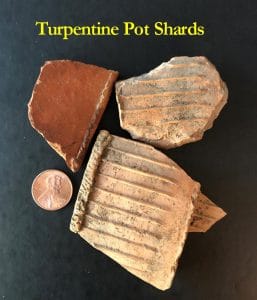The odd-looking vertical scars occasionally found on the trunks of pine trees are signs of times gone by. Known as “cat faces,” these scars are what remain of the forest-based turpentine industry that dates back to colonial times.
The earliest European wooden ships depended upon a combination of tar, pitch, and turpentine rendered from local conifers. Tar was used to waterproof ropes. Pitch was used to caulk and paint hulls, making them waterproof. Turpentine was used to make paints for ships and buildings.
The discovery of what were vast forests of pines in the newfound North American colony made the “naval stores” industry the first major one in the colonies, dating to the early 1700s. This source of naval products was so important to Britain that laws were passed to add incentive for colonial production (less tax).

Cat faces were made using special curved-bladed hacks that created the round-bottomed slashes. Once carved, the sap would flow into the pot, collected every few weeks, and rendered through a distilling process into turpentine and rosin (the clear residue left behind).
The cat faces that we still see today date to the late 1960s and early 1970s when the last of the turpentine was collected from local forests. Although some turpentine is still rendered for a variety of medicinal and cosmetic uses, it has largely been replaced by mineral spirits, a petroleum-based product.
Turpentine remains, however, a key ingredient in many everyday products, like Vicks VapoRub and common antiseptics. Rosin is used to improve grip by baseball players, weightlifters, gymnasts, and ballet dancers and to treat the bow of violin players. On a more local level, a pine oil and resin product called Pineolene is produced in Hurley, Mississippi and used to treat pains, cuts, scratches, burns and aching feet!
So, next time you walk past a pine tree, or if you are lucky enough to encounter a cat face in the woods, think about what these and other plants provide to make our lives and the lives of our ancestors better.
The tree with the cat face shown here stands along the Fontainebleau Trail, a part of the Mississippi Sandhill Crane Refuge near Ocean Springs. Look for it just off the trail in the hard, right-hand turn on the hill overlooking the bayou, just before the “Bayou” interpretive sign.
Hope to see you in our great outdoors!